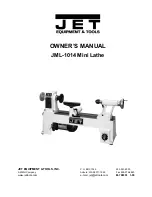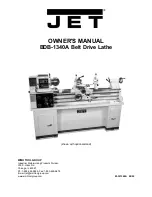
Now draw the skew straight back whilst raising
the handle slowly, until the edge of the heel at
the pencil line starts to cut.
As the edge begins to cut, roll the skew in the
direction of the vee, so that the exact portion
of the edge, when started cutting, will travel in
a 90° arc down to the bottom of the vee.
Upon reaching the bottom of the vee, the skew
should be on edge. Reverse the movements to
cut the side of the adjacent bead.
It is important that only the extreme heel should
do the cutting. This means that the bottom edge
of the bevel, next to the vee, must at all times
be tangent to the arc of the bead being
for med.
Easier beads can be shaped with a spear point
chisel. Use pencil marks and sizing cuts as
before. Push the chisel straight into each cut
and rotate it hor izontally to round off the
adjacent edges. It must be moved slightly in
the direction of rotation at the same time, to
keep the point from digging into the adjacent
b e a d .
8. CUTTING COVES (CONCLAVES)
This is the most difficult single cut to master, but
one of the most important in good wood turning.
First, use pencil marks to indicate the edges.
Then rough-it out to within about 3mm of the
desired finish surface by scraping with the
gouge or round nose chisel. If the cove is to be
very wide, sizing cuts can be made to plot the
roughing out.
Once it is roughed out, the cove can be finished
in two cuts, one from each side to the bottom
centre.
At the start of either cut, the gouge is held with
handle high and the two sides of blade held
between the thumb and forefinger of tool rest
hand, just behind the bevel.
Position the fingers ready to roll the blade into
cove. Hold the blade so that bevel is at a 90°
angle to the work axis, with the point touching
the pencil line and pointing into work axis.
From here, depress the tip slightly to start the
cut, then continue to move tip down in an arc
toward the bottom centre cove, at the same
time rolling chisel uniformly so that at the end of
the cut it will be flat at the bottom of the cove.
The object is to keep the extreme tip of the
gouge doing the cutting from star t to finish.
Reverse movements to cut the opposite side.
Coves can be scraped to finish using the round
nose chisel or a file, but these methods do not
generally produce perfectly curved coves.
9. MAKING A LONG CONVEX CUTS
First turn work down to approximate size, using
sizing cuts (as required) to determine various
diameters. Finish cut can then be made with
either skew or gouge.
If the skew is used, the principles of operation
are the same as those employed in cutting a
bead, except that the curve is longer and may
be irregular. Use the extreme heel throughout.
Start at the longer end of the curve (if curve is
irregular) and progress toward the steeper end.
If a gouge is used, make the cut in the same
direction. Start with the handle well back from
the point, swinging it in the direction of tool travel
to overtake the point, if necessary, when the
steep part of the curve is reached. The object is
to keep the extreme point doing the cutting
throughout, with the bevel at a tangent to the
curve as much as possible.
10. MAKING LONG TAPER CUTS
Long taper cuts are made like long convex cuts,
with the skew or gouge. However, the angle
between the cutting edge and handle is kept
constant during the entire cut. The handle is
not swung around. Always cut downhill. Do not
cut too deeply at the centre of the taper.
20
Fig. 34
Fig. 33
Fig. 32
Fig. 31
Содержание 6500685
Страница 1: ...OPERATING MAINTENANCE INSTRUCTIONS 0408 40 WOODLATHE 40 WOODLATHE Model No CWL1000 Part No 6500685...
Страница 31: ...31 PARTSDIAGRAM...
Страница 32: ......



































